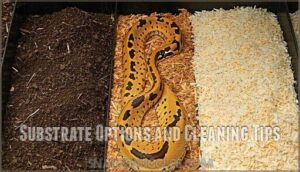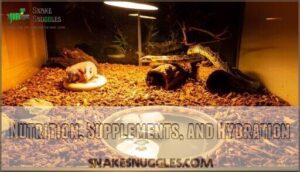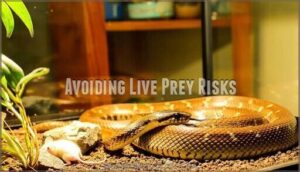This site is supported by our readers. We may earn a commission, at no cost to you, if you purchase through links.

These nonvenomous constrictors display remarkable diversity—from California kingsnakes‘ bold black-and-white bands to scarlet kingsnakes‘ vibrant coral snake mimicry. You’ll find five major species dominating the pet trade: California, Eastern, Florida, Speckled, and Desert varieties.
Adults typically reach 1-1.5 meters, featuring smooth, glossy scales and patterns ranging from bold rings to intricate spots. Their hardy nature makes them perfect for beginners, while experienced keepers appreciate their fascinating behaviors and 15-20 year lifespan.
Proper habitat setup requires 40-gallon enclosures with temperature gradients and appropriate humidity levels—surprisingly straightforward once you understand their specific environmental needs.
Table Of Contents
- Key Takeaways
- Kingsnake Species and Their Unique Features
- Creating The Ideal Kingsnake Habitat
- Feeding and Daily Care for Kingsnakes
- Health, Handling, and Behavior Insights
- Responsible Ownership and Legal Considerations
- Frequently Asked Questions (FAQs)
- What is the best setup for a king snake?
- What is the friendliest kingsnake species?
- Are king snakes good pets?
- Are kingsnakes wild animals?
- Are kingsnakes venomous?
- Do people like kingsnakes?
- What is the lifespan of a king snake?
- Do king snakes like to be handled?
- Do king snakes make good pets?
- What size tank does a king snake need?
- Conclusion
Key Takeaways
- You’ll need a proper setup – A 40-gallon enclosure minimum with temperature gradients (78-88°F), an appropriate substrate like aspen shavings, and multiple hiding spots to keep your kingsnake healthy and comfortable.
- They’re beginner-friendly with manageable care – You can expect 15-20 years of companionship from these docile, nonvenomous constrictors that rarely bite and adapt well to handling with consistent interaction.
- Feeding is straightforward but age-specific – You’ll feed juveniles every 5-7 days with smaller prey, while adults eat every 10-14 days, using pre-killed frozen rodents for safety and proper nutrition.
- Choose captive-bred specimens and research local laws – You should buy from reputable breeders rather than wild-caught snakes, and verify your local regulations since some areas restrict snake ownership.
Kingsnake Species and Their Unique Features
You’ll discover that kingsnakes comprise several distinct species across North America, each showcasing unique color patterns and behavioral traits that make them fascinating reptilian companions.
These nonvenomous constrictors display remarkable diversity in their appearance, from the classic black-and-white bands of California kingsnakes to the coral snake mimicry exhibited by scarlet kingsnakes.
Common Kingsnake Types in The US
Across the United States, five major Kingsnake Species dominate the pet trade landscape.
California Kingsnakes showcase striking banded patterns, while Eastern Kingsnakes display distinctive chain-link markings.
Florida Kingsnakes transform from brown to yellow with age, and Speckled Kingsnakes feature unique dotted patterns.
Desert Kingsnakes thrive in southwestern regions.
These Pet Kingsnakes offer diverse Snake Morphs for enthusiasts seeking captive-bred specimens with predictable temperaments and established US Distribution ranges.
Physical Characteristics and Color Patterns
Kingsnakes showcase remarkable diversity in their physical appearance, making species identification both fascinating and challenging.
These serpents typically measure 1-1.5 meters, though some California kingsnakes reach impressive 2.1-meter lengths.
Their scale texture remains consistently smooth and glossy across all kingsnake species.
Pattern variations include bold rings, crisp stripes, and scattered spots, while snake morphs range from solid black Mexican kingsnakes to vibrant red-black-white combinations.
Body length varies substantially between species, with scarlet kingsnakes maxing out around 76 centimeters.
Mimicry and Protective Coloration
Mastering nature’s art of deception, many kingsnakes display striking coral snake mimicry through red-black-yellow color patterns.
These protective colors create convincing venomous mimics that deter predators effectively.
Snake camouflage techniques include banded patterns and vibrant hues that signal danger without actual venom.
Understanding these mimicry types helps you appreciate your kingsnakes as pets’ evolutionary brilliance in survival strategies.
Species Popular in The Pet Trade
Several kingsnake species have captured hearts in the pet trade, offering snake enthusiasts accessible entry points into reptile ownership. These species selection favorites combine striking appearance with manageable care requirements.
Kingsnakes offer reptile enthusiasts the perfect blend of stunning beauty and beginner-friendly care requirements
Popular pet kingsnake varieties include:
- California Kingsnakes – Hardy beginners’ choice with diverse color morphs
- Milk Snakes – Vibrant coral snake mimics with docile temperaments
- Mexican Black Kingsnakes – Stunning solid-black specimens prized by collectors
- Scarlet Kingsnakes – Compact southeastern natives perfect for smaller setups
Snake breeding programs have developed captive-bred lines that display consistent temperaments and reduced stress compared to wild-caught specimens, making kingsnake care more predictable for novice keepers. Understanding proper snake care is essential for a successful pet ownership experience.
Photo Gallery of Kingsnake Varieties
Visual documentation captures each kingsnake’s unique beauty through careful photography.
When photographing your pet, natural lighting reveals true Color Variations in Kingsnake Morphs. Snake Patterns shine best against neutral backgrounds that don’t compete with intricate banding.
Different Kingsnake Species display remarkable diversity—from California’s bold stripes to milk snake’s coral mimicry.
Document your snake’s growth with regular photos, creating a personal gallery showcasing pet kingsnake care progress, highlighting the importance of natural lighting.
Creating The Ideal Kingsnake Habitat
Creating a proper habitat for your kingsnake requires careful attention to enclosure specifications, substrate selection, and environmental controls.
You’ll need to balance temperature gradients, humidity levels, and hiding opportunities to replicate their natural conditions and guarantee your snake thrives in captivity.
Enclosure Size and Design
When selecting your kingsnake enclosure, you’ll want a 40-gallon vivarium minimum for adults, though larger is always better.
Glass terrariums with secure screen tops provide excellent ventilation systems and visibility. Choose enclosure materials like PVC or melamine for superior heating options and humidity control.
Proper lighting designs aren’t essential since these nocturnal creatures prefer dimmer conditions. Space requirements should allow your snake to stretch fully—freedom to move reduces stress substantially.
Maintaining proper temperature gradients is vital, and understanding temperature control methods can help create an ideal environment for your kingsnake.
Substrate Options and Cleaning Tips
Choose aspen shavings or cypress mulch as your enclosure substrate – both control humidity naturally while absorbing waste effectively.
Paper towels work for quarantine situations. Spot-clean immediately when you notice waste, and replace substrate monthly for ideal tank maintenance.
Avoid cedar or pine shavings, which contain harmful oils that irritate your kingsnake’s respiratory system. For the best results, consider using high-quality aspen shavings products to maintain a clean and healthy environment.
Temperature and Humidity Management
Proper temperature gradients create the foundation for healthy kingsnake habitat management.
Your vivarium requires precise thermal cycles with heat sources maintaining basking spots at 85-90°F while cool zones stay 70-78°F.
Moisture control through 40-60% humidity levels prevents respiratory issues and supports proper shedding.
Here are three critical monitoring requirements:
- Digital thermometers at multiple enclosure points to track temperature gradients accurately
- Hygrometers with probes placed mid-enclosure for reliable humidity readings
- Thermostat-controlled heating to prevent dangerous temperature spikes that stress your snake
Heat sources like halogen bulbs or under-tank heaters provide consistent warmth when properly regulated.
Nighttime drops to 70-75°F simulate natural conditions your kingsnake expects.
For ideal kingsnake care, understanding proper snake care is essential to create a thriving environment.
Hiding Spots and Environmental Enrichment
Kingsnakes require multiple Snake Hides throughout their vivarium to feel secure.
Place one hide on the warm side and another on the cool side of your snake enclosure.
Add Visual Barriers like artificial plants or branches to create natural-looking Hiding Places.
Simple Environmental Toys such as Climbing Structures encourage natural behaviors and reduce stress in your pet snake habitat.
Safe Decor and Enclosure Setup Photos
Decor Safety becomes paramount when outfitting your snake enclosure with accessories that enhance both aesthetics and functionality. Natural branches, artificial plants, and water dishes must lack sharp edges or toxic materials that could harm your kingsnake.
- Smooth driftwood pieces positioned at various angles create climbing opportunities while maintaining structural stability
- Non-toxic artificial foliage provides visual barriers without requiring maintenance or harboring parasites
- Ceramic water bowls with weighted bases prevent tipping during exploration sessions
- Rock formations with secure placement offer basking spots without creating unstable cave-ins, ensuring overall Decor Safety
Feeding and Daily Care for Kingsnakes
Proper feeding forms the foundation of successful kingsnake care, with specific dietary requirements varying substantially between juvenile and adult specimens.
You’ll need to establish consistent feeding schedules and understand species-specific nutritional needs to maintain peak health throughout your snake’s lifespan, which is crucial for successful kingsnake care.
Diet by Age and Species
Feeding schedules vary dramatically across kingsnake life stages, with hatchlings requiring frequent pinkie mice while adults thrive on larger prey less often.
Understanding these species variations and age-specific nutritional needs is vital for your snake’s health and natural feeding behavior throughout its captive life.
Proper kingsnake food selection is essential for their development, and considering the right kingsnake food options can make a significant difference in their overall well-being.
| Life Stage | Prey Size | Feeding Frequency |
|---|---|---|
| Hatchlings (0-6 months) | Pinkie mice | Every 5-7 days |
| Juveniles (6-18 months) | Fuzzy to adult mice | Every 7-10 days |
| Adults (18+ months) | Adult mice/small rats | Every 10-14 days |
| California Kingsnakes | Rodents, occasional eggs | Standard schedule |
| Eastern Kingsnakes | Rodents, other snakes | May skip meals seasonally |
Safe Feeding Practices and Frequency
Once you’ve established what your kingsnake eats, focus on how you deliver those meals.
Feed juveniles every 5-7 days, adults every 10-14 days using feeding techniques like pre-killed frozen prey.
Proper meal frequency prevents overfeeding while ensuring adequate snake nutrition.
Always use feeding tongs for safety and monitor your pet’s body condition to adjust prey selection accordingly.
Nutrition, Supplements, and Hydration
Three essential elements fuel your kingsnake’s vitality: proper nutrition, clean water, and targeted supplements.
Feeding Techniques should focus on appropriately-sized frozen prey to meet their Dietary Needs.
Fresh water bowls guarantee prime Hydration Methods, while Water Quality remains paramount for kingsnake health.
Most pet snake feeding scenarios require minimal Supplement Options, as whole prey provides complete snake nutrition through proven snake care tips.
Avoiding Live Prey Risks
Live prey poses significant risks that frozen alternatives eliminate entirely.
Rodents can injure your kingsnake with bites or scratches, potentially causing infections or stress. Pre-killed prey also reduces feeding aggression and territorial behaviors in your snake.
Risk Management considerations:
- Prey Selection matters – injured snakes from live rodent attacks require expensive veterinary treatment
- Feeding Safety improves when switching to frozen prey, eliminating bite wounds and parasites
- Snake Nutrition remains essential with proper thawing techniques, maintaining essential nutrients your pet needs
Understanding proper prey size guidelines is vital for a snake’s health and well-being.
Sample Feeding Schedules and Food Prep Images
Younger kingsnakes eat every 5-7 days, while adults feed every 10-14 days.
Pre-killed frozen mice offer the safest prey items for your snake nutrition needs. Thaw rodents completely in warm water, checking temperatures before serving.
Adult females require larger meal frequency during breeding season. Quality food variety prevents nutritional deficiencies in captive snake pet guide management.
Health, Handling, and Behavior Insights
Understanding your kingsnake’s health status and behavior patterns forms the foundation of successful pet ownership.
Proper handling techniques and early recognition of stress signals will help you build a trusting relationship while maintaining your snake’s physical and psychological well-being, which is crucial for successful pet ownership.
Recognizing Healthy Kingsnakes
Healthy kingsnakes display bright, clear eyes and smooth, supple skin that reflects their liveliness.
Their Kingsnake Anatomy should show consistent body weight without visible ribs or obesity.
Alert Snake Behavior includes active tongue-flicking and responsive movement when approached.
Key Health Signs encompass regular shedding cycles, steady appetite, and normal elimination patterns.
During Pet Inspection, examine for mites, retained shed, or respiratory distress.
Understanding kingsnake behavior and morphology helps identify when your pet snake breeds are thriving through proper Kingsnake Care and appropriate kingsnake diet.
Common Illnesses and Preventive Care
Respiratory issues plague up to 20% of captive kingsnakes, typically from poor humidity control or dirty enclosures.
Watch for wheezing, mouth gaping, and nasal discharge.
Skin infections and scale rot affect 15-30% of pets on damp substrates.
Internal parasites impact 25% of new acquisitions.
Annual veterinary care and proper husbandry prevent most kingsnake health concerns through parasite control and metabolic disease prevention.
Handling Techniques and Building Trust
Through gentle handling and consistent interaction, you’ll build trust with your kingsnake.
Begin with brief, calm sessions, supporting their body weight fully.
Move slowly, avoiding sudden movements that trigger defensive responses.
Regular handling sessions help snake taming, though some individuals remain more skittish.
Use proper calming techniques like approaching from the side, never from above.
Handling safety requires confidence—nervous handlers often create anxious snakes.
Effective snake handling involves understanding safe handling techniques to minimize stress and promote trust.
Behavioral Traits and Stress Signs
Reading kingsnake behavior reveals stress signals before problems escalate.
Watch for defensive coiling, excessive hiding, or aggressive striking when approached.
Behavioral quirks include tail twitching, musking, and food refusal during stress.
Snake body language reveals comfort levels through relaxed postures versus rigid positioning.
Environmental enrichment reduces stress through varied hiding spots and climbing opportunities.
Understanding these nonvenomous constrictors’ natural behaviors helps snake pet owners recognize when handling techniques need adjustment, promoting a better understanding of snake behavior.
Shedding, Breeding, and Seasonal Changes
Kingsnakes undergo fascinating transformations throughout their lives.
The molting process occurs every 4-8 weeks in juveniles, slowing to 3-4 times annually in adults.
During shedding, their eyes turn milky blue, signaling upcoming skin renewal.
Snake pet owners should increase humidity and provide rough surfaces for shedding techniques.
Breeding cycles typically occur in spring after seasonal adaptation to cooler winter temperatures.
Reproductive health peaks when kingsnakes experience natural temperature fluctuations, making kingsnake breeding successful for dedicated enthusiasts practicing proper kingsnake conservation methods, which is crucial for proper kingsnake care.
Responsible Ownership and Legal Considerations
Before welcoming a kingsnake into your home, you’ll need to understand the significant time commitment these reptiles require, as they can live 15-30 years in captivity with proper care.
You must also research your local and state regulations, since some jurisdictions restrict or prohibit keeping certain snake species as pets.
You should be aware that understanding the regulations is crucial for a smooth experience.
Lifespan and Long-Term Commitment
Captive kingsnakes typically live 15-25 years with proper pet reptile care, making snake longevity a significant factor in pet ownership decisions.
This extended kingsnake lifespan means you’re committing to decades of animal care responsibilities.
Your snake pet habitat requires consistent maintenance, and kingsnake health depends on long term commitment to proper environmental conditions, nutrition, and veterinary care throughout their lives.
Legal and Ethical Pet Ownership
Before bringing home kingsnake pets, research your local ownership laws and permit requirements.
Many states regulate nonvenomous snakes differently, and some municipalities ban reptile ownership entirely.
Responsible ownership means prioritizing animal welfare through proper snake captivity care, supporting ethical breeding practices, and considering pet insurance for veterinary expenses.
- Check state and local permit requirements before purchase
- Verify housing regulations allow pet reptile care in your area
- Research reputable breeders who prioritize animal welfare standards
Captive-Bred Vs. Wild-Caught Kingsnakes
When choosing kingsnake pets, captive breeding offers superior outcomes over wild capture.
Captive-bred specimens exhibit better snake acclimation, reduced parasite loads, and predictable feeding behaviors on commercial diets.
Wild-caught individuals face higher mortality rates, stress-related health issues, and feeding refusals during captivity care phases.
Conservation ethics strongly favor captive breeding methods, protecting wild populations while ensuring healthier nonvenomous snakes for responsible ownership.
For a successful breeding program, understanding kingsnake breeding is essential to produce healthy offspring, which is a key aspect of responsible ownership and supports conservation ethics by protecting wild populations.
Myths and Facts About Kingsnakes
Countless Kingsnake Myths persist despite scientific evidence.
These Nonvenomous Snake species aren’t immune to all venoms—they possess limited Venom Resistance against specific prey.
King snake cannibalism occurs but isn’t constant behavior.
Pet Misconceptions include claims they’re aggressive; Lampropeltis species are typically docile.
Snake Immunity legends exaggerate their abilities, though kingsnake morphology does provide some protection against certain venomous species through specialized proteins.
Frequently Asked Questions (FAQs)
What is the best setup for a king snake?
Picture your kingsnake’s sanctuary: a spacious 40-gallon terrarium with secure ventilation, ambient temperatures of 78-85°F, and a basking spot reaching 88°F.
You’ll need hiding spots, water dish, and substrate for burrowing comfort.
What is the friendliest kingsnake species?
California kingsnakes (Lampropeltis getula californiae) rank as the friendliest species.
They’re naturally docile, rarely bite, and adapt quickly to handling.
Their calm temperament makes them perfect for beginners seeking a manageable, interactive pet.
Are king snakes good pets?
One breeder’s California kingsnake lived 28 years, demonstrating their longevity potential.
You’ll find kingsnakes make excellent pets due to their docile nature, manageable size, and straightforward care requirements, making them ideal for both beginners and experienced keepers.
Are kingsnakes wild animals?
Yes, kingsnakes are wild animals native to North America. They’re nonvenomous constrictors that naturally inhabit diverse ecosystems from Canada to Ecuador, thriving in grasslands, forests, and deserts throughout their range.
Are kingsnakes venomous?
Wondering if you need to fear that bite?
No, kingsnakes aren’t venomous – they’re nonvenomous constrictors that kill prey by squeezing.
They actually hunt venomous snakes and possess natural immunity to their venom.
Do people like kingsnakes?
People absolutely love keeping kingsnakes as pets.
You’ll find them surprisingly docile, easy to care for, and fascinating to watch.
They’re hardy, adaptable, and make excellent beginner snakes for reptile enthusiasts.
What is the lifespan of a king snake?
You’re probably wondering if your scaly companion will outlive your goldfish’s impressive three-day record.
King snakes typically live 15-20 years in captivity with proper care, substantially longer than their wild counterparts due to consistent food and veterinary attention.
Do king snakes like to be handled?
King snakes can adapt to handling but don’t naturally enjoy it like mammals do. They’ll tolerate gentle, consistent interaction once they’re comfortable with you and their environment.
Do king snakes make good pets?
Yes, kingsnakes make excellent pets! They’re docile, rarely bite, tolerate handling well, and don’t require complex care. You’ll appreciate their hardiness, manageable size, and striking patterns that’ll impress visitors.
What size tank does a king snake need?
Adult kingsnakes reaching up to 1 meters need surprisingly spacious accommodations. You’ll want a 40-gallon tank minimum for most species, though larger specimens require 75+ gallons for proper movement and thermoregulation.
Conclusion
Like a reliable companion that never disappoints, kingsnakes represent an ideal choice for reptile enthusiasts seeking both beauty and manageable care requirements.
This complete guide demonstrates that successful kingsnake ownership depends on understanding their specific habitat, dietary, and behavioral needs.
Whether you’re attracted to California kingsnakes‘ striking patterns or Eastern varieties’ robust nature, these remarkable constrictors offer decades of rewarding companionship.
With proper preparation and commitment, kingsnakes as pets provide an exceptional gateway into the fascinating world of reptile keeping.
- https://www.merriam-webster.com/dictionary/cosmopolitan
- https://en.wikipedia.org/wiki/Dormancy
- https://californiaherps.com/snakes/pages/l.zonata.html
- https://web.archive.org/web/20050816125437/http:/www.dfg.ca.gov/hcpb/cgi-bin/read_one.asp?specy=reptiles&idNum=31
- http://reptile-database.reptarium.cz/species?genus=Lampropeltis&species=webbi


















